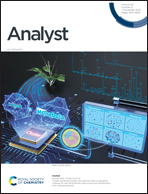Stress induced self-rollable smart-stent-based U-health platform for in-stent restenosis monitoring†
Abstract
To date, several smart stents have been proposed to continuously detect biological cues, which is essential for tracking patients’ critical vital signs and therapy. However, the proposed smart stent fabrication techniques rely on conventional laser micro-cutting or 3D printing technologies. The sensors are then integrated into the stent structure using an adhesive, conductive epoxy, or laser micro-welding process. The sensor packaging method using additional fabrication processes can cause electrical noise, and there is a possibility of sensor detachment from the sent structure after implantation, which may pose a significant risk to patients. Herein, we are demonstrating for the first time a single-step fabrication method to develop a smart stent with an integrated sensor for detecting in-stent restenosis and assessing the functional dynamics of the heart. The smart stent is fabricated using a microelectromechanical system (MEMS)-based micromachining technology. The proposed smart stent can detect biological cues without additional power and wirelessly transmit the signal to the network analyzer. The cytocompatibility of the smart stent is confirmed through a cytotoxicity test by monitoring the cell growth, proliferation, and viability of the cultured cardiomyocytes. The capacitance of the smart stent exhibits an excellent linear relationship with the applied pressure. The exceptional sensitivity of the pressure sensor enabled the proposed smart stent to detect biological cues during in vivo analysis. The preliminary findings confirmed the proposed smart stent's higher level of structural integrity, durability and repeatability. Finally, the practical feasibility of the smart stent is demonstrated by monitoring diastole and systole at various beat rates using a phantom. The results of the phantom study showed a similar pattern to the human model, indicating the potential use of the proposed multifunctional smart stent for real-time applications.

- This article is part of the themed collection: Analyst HOT Articles 2022


 Please wait while we load your content...
Please wait while we load your content...